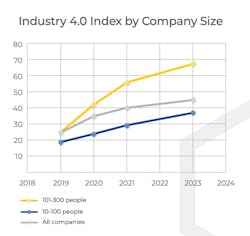Manufacturers Are Adopting Tech, Diversifying Talent—But They Need to Step It Up
There’s a widening gap between the Industry 4.0 haves and have-nots. Medium and large manufacturers who have invested in new tech are reaping the results and going back for more. Meanwhile, smaller manufacturers are putting off taking the plunge.
That’s among the takeaways of MAGNET’s 2023 Manufacturing Survey, which picks the minds of manufacturers on pressing industry issues. The results, from 217 respondents, reveal an extraordinary story of growth and change and provide a peek at trends that define our current manufacturing era, from the shifting shape of worker acquisition and retention to the prevalence of owners considering a sale.
MAGNET is Northeast Ohio’s Manufacturing Extension Partnership. While the results come from manufacturers throughout that region—including Cleveland, Akron, and Youngstown—they tell a tale that resonates beyond those borders. Here’s a look at some of the key takeaways on leadership, innovation and talent.
Leaders are investing in their businesses, but many are also exploring a sale.
In a marketplace only growing more competitive, it’s vital that manufacturers pump their profits back into the business. So, I’m delighted to see that they appear to be doing just that, with 67% of leaders saying they’re investing in manufacturing capabilities and another 54% saying they’re investing in their workforce.
But here’s the kicker: Even as leaders pursue reinvestments, they’re also keeping their options open to get out of the business entirely. A third of Northeast Ohio manufacturers have considered selling over the last year. In the same time period, about 1 in 5 were either acquired or part of an acquisition, a 45% increase over two years prior. About 35% of companies have succession plans in place for senior leadership, a step in the right direction.
In this environment of succession planning, it’s also encouraging to see the face of manufacturing leadership changing. We saw an 80% increase in people of color in supervisory and management roles last year (vs. 2021 survey results). The much-needed infusion of diversity is currently happening at the lower and mid-level management levels, but I’d expect those numbers to translate into increased diversity up the ladder and into senior level positions in the coming years.
The gap between Industry 4.0 haves and have-nots is growing.
Here’s the good news: Overall, we’ve seen an 80% jump in Industry 4.0 adoption since 2019. Companies are using advanced tech to goose productivity and reduce cost, to increase capacity, and to make up for the gap in available talent.
Here’s the caveat: The growth in implementation started from a relatively low baseline, so we have a long way to go. Most technologies still sit below 20% adoption across the Northeast Ohio market. And the jump in adoption hasn’t been evenly spread across companies; it’s the medium and large manufacturers that are all in, while smaller firms fall behind. A full 72% of manufacturers have yet to implement efficiency-yielding technologies like cobots, automation, and 3D printing.
The region’s first-ever Industry 4.0 Index, which we designed to track the adoption rate of emerging technologies, sheds even more light on the disparity. Overall, the index has risen from 25 to 45 since 2019, but companies with 10 to 100 employees have an average index less than 40, while companies with 101 to 300 people have an average index of nearly 70.
When it comes to innovation, results are mixed. For 70% of manufacturers, it doesn’t register as one of their top three priorities. Yet 58% of companies have launched a new product since 2022, and those products are adding significant money to the top line. Companies said the new products drove 7% of their revenue.
Our talent strides are encouraging—but insufficient.
Concerns over labor shortages hit a fever pitch during the pandemic, but the industry appears to have since taken real steps to win new recruits. That begins with paying higher wages. Average starting salaries are up to $16.30 an hour from $14.10 just two years ago, an increase of 16%. Mid-skill jobs have jumped even further, rising to $21.10 an hour, which is up 21% from $17.50 two years ago. It’s necessary, but it doesn’t come without some level of pain—40% of manufacturers say rising wages are hampering growth.
That’s not the only way manufacturers are evolving to bring aboard new hires and keep them around. Nearly 3 in 5 manufacturers are looking for ways to add flexibility for workers, introducing new hours or shift permutations[LP1] , cross-training roles or paying workers more frequently. Empowering employees along their career journeys has also become a point of emphasis. Half of all companies offer tuition reimbursement, while 65% are increasing their formal apprenticeship or on-the-job training programs.
And I’m incredibly proud of this: More than 2,000 people of color have entered manufacturing in Northeast Ohio over the last two years. Manufacturers should be ramping up diversity and inclusion not only because it helps them build more well-rounded, productive teams, but also because it will be vital to engage all labor pools if we’re to close the talent gap.
Overall, Northeast Ohio added 10,000 new jobs in manufacturing in two years, which puts the region already a third of the way to its 10-year goal. We’ve even managed to slightly close the talent gap in entry- and mid-level jobs; 20,000 of them sit empty today, compared to 23,000 two years ago. But that number still represents almost 10% of all manufacturing jobs across the region, and with retirements across the workforce spiking—1 in 5 manufacturers expects at least 16% of their workforce to retire in the next three years—we’ll need to stay committed to recruitment and retention.
That double-sided sword is par for the course in manufacturing right now, as this study reveals. The truth is in the nuance. We’re taking steps to shrink the talent gap, but the labor shortage will remain a thorn in the side of manufacturers indefinitely. We’re seeing Industry 4.0 technology implementation increase, but it’s still vital that we get small shops to buy in, as well. Leaders are putting cash back into their businesses, but this succession pivot-point looms large in the future of so many companies.
In this rapidly evolving environment, manufacturing leaders can’t afford to fall asleep at the wheel. The way our industry shifts over the next three years will have a massive impact on the future.
Ethan Karp is president & CEO, MAGNET (the Manufacturing and Growth Network), an Ohio Manufacturing Extension Partnership.
About the Author
Ethan Karp
President & CEO, MAGNET
As President and CEO of MAGNET, Ethan Karp brings his wide range of experiences to drive economic prosperity in Northeast Ohio through innovation and invention. Prior to focusing on building the future of Ohio from its strength in manufacturing with MAGNET in 2013, Ethan advised Fortune 500 companies to innovate and grow with global consulting firm McKinsey in Cleveland. Ethan is a trained scientist who spent many years trying to uncover how the brain works while attaining a Ph.D. in Chemical Biology from Harvard and undergraduate degrees in physics and biochemistry from Miami University.

